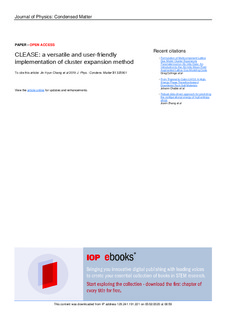| dc.contributor.author | Chang, Jin Hyun | |
| dc.contributor.author | Kleiven, David | |
| dc.contributor.author | Melander, Marko | |
| dc.contributor.author | Akola, Jaakko | |
| dc.contributor.author | Garcia-Lastra, Juan Maria | |
| dc.contributor.author | Vegge, Tejs | |
| dc.date.accessioned | 2020-02-05T09:00:29Z | |
| dc.date.available | 2020-02-05T09:00:29Z | |
| dc.date.created | 2019-09-17T15:58:13Z | |
| dc.date.issued | 2019 | |
| dc.identifier.citation | Journal of Physics: Condensed Matter. 2019, 31 (32), . | nb_NO |
| dc.identifier.issn | 0953-8984 | |
| dc.identifier.uri | http://hdl.handle.net/11250/2639704 | |
| dc.description.abstract | Materials exhibiting a substitutional disorder such as multicomponent alloys and mixed metal oxides/oxyfluorides are of great importance in many scientific and technological sectors. Disordered materials constitute an overwhelmingly large configurational space, which makes it practically impossible to be explored manually using first-principles calculations such as density functional theory due to the high computational costs. Consequently, the use of methods such as cluster expansion (CE) is vital in enhancing our understanding of the disordered materials. CE dramatically reduces the computational cost by mapping the first-principles calculation results on to a Hamiltonian which is much faster to evaluate. In this work, we present our implementation of the CE method, which is integrated as a part of the atomic simulation environment (ASE) open-source package. The versatile and user-friendly code automates the complex set up and construction procedure of CE while giving the users the flexibility to tweak the settings and to import their own structures and previous calculation results. Recent advancements such as regularization techniques from machine learning are implemented in the developed code. The code allows the users to construct CE on any bulk lattice structure, which makes it useful for a wide range of applications involving complex materials. We demonstrate the capabilities of our implementation by analyzing the two example materials with varying complexities: a binary metal alloy and a disordered lithium chromium oxyfluoride. | nb_NO |
| dc.language.iso | eng | nb_NO |
| dc.publisher | IOP Publishing | nb_NO |
| dc.rights | Navngivelse 4.0 Internasjonal | * |
| dc.rights.uri | http://creativecommons.org/licenses/by/4.0/deed.no | * |
| dc.title | CLEASE: a versatile and user-friendly implementation of cluster expansion method | nb_NO |
| dc.type | Journal article | nb_NO |
| dc.type | Peer reviewed | nb_NO |
| dc.description.version | publishedVersion | nb_NO |
| dc.source.pagenumber | 13 | nb_NO |
| dc.source.volume | 31 | nb_NO |
| dc.source.journal | Journal of Physics: Condensed Matter | nb_NO |
| dc.source.issue | 32 | nb_NO |
| dc.identifier.doi | 10.1088/1361-648X/ab1bbc | |
| dc.identifier.cristin | 1725819 | |
| dc.description.localcode | Original content from this work may be used under the terms of the Creative Commons Attribution 3.0 licence. Any further distribution of this work must maintain attribution to the author(s) and the title of the work, journal citation and DOI. | nb_NO |
| cristin.unitcode | 194,66,20,0 | |
| cristin.unitname | Institutt for fysikk | |
| cristin.ispublished | true | |
| cristin.fulltext | original | |
| cristin.qualitycode | 1 | |

